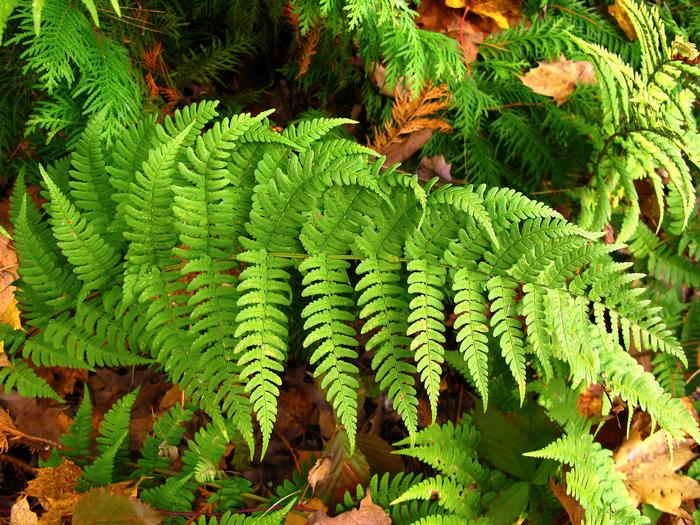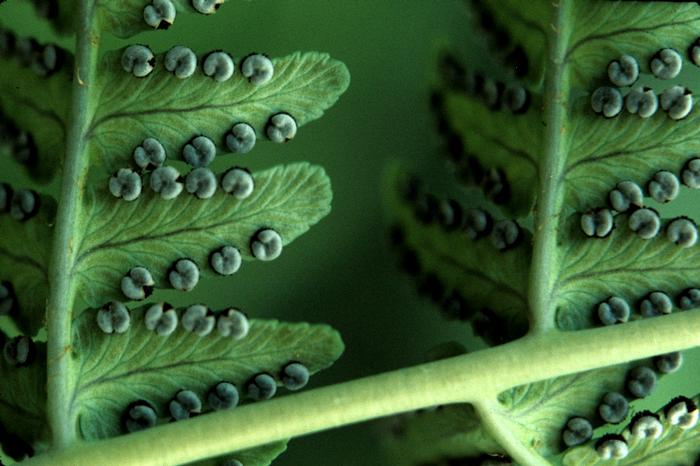General Description
Bloom Description: No flowers! The leathery fronds are slow to appear in spring, usually arising in late May.
Growth Habit & Shape: Individual marginal wood ferns are mid-sized compared to other fern species; the fronds emerge to create a single vase-shaped cluster. This ferm may form colonies, but individuals remain visually distinct.
Soil Preferences: Marginal wood fern is commonly found in dense forest conditions. While it prefers rich, well-draining, humusy soils, it tolerates a wide variety of other soil conditions. It grows well in dry locations but prefers shade.
Root Description: The roots are an upright rhizome, meaning they form individual vase-shaped plants in colonies.
Garden Uses: Dryopteris marginalis can be used for naturalizing as well as in the garden. Its deep green foliage makes an excellent companion to spring ephemerals, filling in the gaps when spring wildflowers fade. It works equally well as a specimen as a mass planting.
Best Management & Maintenance: Wood ferns are incredibly easy to care for. Dead fronds can be cut back in spring for a cleaner aesthetic, but new fronds will emerge beautifully regardless. Do not disturb the root bases!
Common Problems: none
Benefits
Ornamental Value: Useful in deep shade for color, form, and winter interest. It also blends with many shade-loving perennials, especially delicately flowering ones.
Wildlife Benefits: Wood ferns (Dryopteris spp.) serve as host plants for caterpillars of the Ghostly Fern Moth, the Marsh Fern Moth, and the Conifer Swift Moth.
Other Practical/Environmental Benefits:
Ecology
Habitat:
Rocky, wooded slopes and ravines, edges of woods, stream banks and roadbanks, and rock walls
Ecosystems:
This species is listed in the following United States National Vegetation Classification macrogroups:
-M016 Southern & South-Central Oak - Pine Forest & Woodland Macrogroup
-M502 Appalachian-Northeastern Oak - Hardwood - Pine Forest & Woodland Macrogroup
-M883 Appalachian-Interior-Northeastern Mesic Forest Macrogroup
-M882 Central Midwest Mesic Forest Macrogroup
-M159 Laurentian-Acadian Pine - Hardwood Forest & Woodland Macrogroup
-M014 Laurentian-Acadian Mesic Hardwood - Conifer Forest Macrogroup
-M506 Appalachian Rocky Felsic & Mafic Scrub & Grassland Macrogroup
-M111 Eastern North American Cliff & Rock Vegetation Macrogroup
Response to Disturbance: Ferns such as Dryopteris marginalis have upright rhizomes for roots which make them appear to have small "trunks" as they grow and soil erodes from around the bases. These trunks produce fronds and roots, and are extremely sensitive to disruption, tending to heave out of the ground when bumped or stepped on. Wild individuals are shored up with leaf litter, which can be replicated in the garden by using leaf mulch. As a particularly shade-loving fern, this species does not respond well to sudden openings in the canopy.
Native State Distributions:
Canada: NB, NF, NS, ON, QC
USA: AL, AR, CT, DC, DE, GA, IA, IL, IN, KS, KY, MA, MD, ME, MI, MN, MO, MS, NC, NH, NJ, NY, OH, OK, PA, RI, SC, TN, VA, VT, WI, WV
Wetland indicator status: FACU
References
Return to Top



